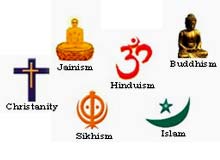In India, religion is a way of life. It is an integral part of the entire Indian tradition. For the majority of Indians, religion permeates every aspect of life, from common-place daily chores to education and politics. Secular India is home to Hinduism, Islam, Christianity, Buddhism, Jainism, Sikhism and other innumerable religious traditions. Hinduism is the dominant faith, practised by over 80% of the population. Besides Hindus, Muslims are the most prominent religious group and are an integral part of Indian society. In fact India has the second largest population of Muslims in the world after Indonesia.

Buddhism
At present Buddhism is one of the major world religions. The philosophy
of Buddhism is based on the teachings of Lord Buddha, Siddhartha Gautama (563
and 483 BC), a royal prince of Kapilvastu, India. After originating in India,
Buddhism spread throughout the Central Asia, Sri Lanka, Tibet, Southeast Asia,
as well as the East Asian countries of China, Mongolia, Korea, Japan and
Vietnam.
Christians
Christianity is one of the prominent religions in India. At present
there are about 25 million Christians in India. It is interesting to note that
the Christian population in India is more than the entire population of Australia
and New Zealandor total population of a number of countries in Europe.
Hinduism
Hinduism is the oldest religion in the world. Hinduism is world's third
largest religion after Christianity and Islam. Hinduism is the dominant
religion in India, where Hindus form about 84 per cent of the total population.
Hinduism is also known as "Sanatan Dharma" or the everlasting
religion.
Islam
One of the prominent religions of India, Islam forms about 12 per cent
of India's population. Though India's contact with Islam had begun much
earlier, the real push came in the 8th century when the province of Sindh was
conquered. Though the Muslims form only 12 per cent of the total population of
India but the influence of Islam on Indian society is much stronger.
Jainism
Jains form less than one percent of the Indian population. For
centuries, Jains are famous as community of traders and merchants. The states
of Gujarat and Rajasthan have the highest concentration of Jain population in
India. The Jain religion is traced to Vardhamana Mahavira (The Great Hero
599-527 B.C.).
Sikhism
Sikhs form about 2 per cent of Indian population. In comparison to other
religions, Sikhism is a younger religion. The word 'Sikh' means a disciple and
thus Sikhism is essentially the path of discipleship. The true Sikh remains
unattached to worldly things.
Zoroastrian
Though the total number of Zoroastrians in Indian population is very
less yet they continue to be one of the important religious communities of
India. According to the 2001 census, there were around 70,000 members of the
Zoroastrian faith in India. Most of the Parsis (Zoroastrians) live in
Maharashtra (mainly in Mumbai) and the rest in Gujarat.
Guru Nanak Dev
Sri Guru Nanak Dev Ji is credited with starting the Sikh religion. He
was the first Guru of the Sikhs and is worshipped next to God. His sole aim in
life was to unify the Hindus and Muslims and form a universal religion of
brotherhood and compassion. He believed that true salvation could be achieved
only by devotion of thought and excellence of conduct.
Lord Mahavira
Lord Mahavira is often credited with the advent of Jainism in India.
However, Jainism existed even before Lord Mahavira was born. He is supposed to
be the twenty-fourth (last) Tirthankara according to the Jain philosophy. A
Tirthankara is an enlightened soul who is born as a human being and attains
perfection through intense meditation.
Adi Shankaracharya
One of the greatest philosophers of India, Adi Shankaracharya founded
the Advaita Vedanta, which is one of the sub-schools of Vedanta. Adi
Shankaracharya whole-heartedly believed in the concept of the Vedas but at the
same time advocated against the rituals and religious practices that were over
exaggerated.
0 comments:
Post a Comment